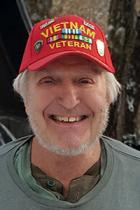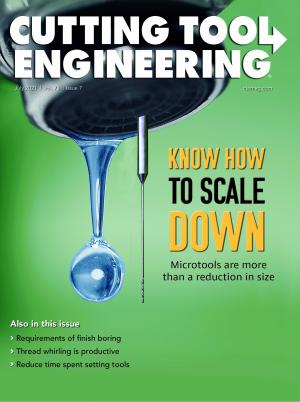Steel mill products can be classified broadly by the mill finishing process, whether hot rolled or cold rolled. Hot-rolled products include structural shapes, round and flat bar, and plate. Cold-rolled products include round, flat and hex bar stock; plate; and sheet metal.
Hot-rolled products don’t have the same level of dimensional accuracy as cold-rolled products and have an iron-oxide coating, but hot-rolled products don’t have the internal stress created by the cold finishing process. The internal stress situation is important to understand because it can lead to unintended consequences when metalworking. If the stress is removed or modified in the metalworking process, it can change the dimensions of the part. The cold working stretches and hardens the steel at the surface and puts the material under tension. Since opposite surfaces are stressed equally, the material is in balance and dimensionally stable.

The photograph shows what happens if cold-rolled steel is used without stress relieving. Image courtesy of B. Taylor
For a flat bar, if one surface is removed by machining, the opposite surface tends to contract and bend the bar. For a thin-walled part made from round bar, if an axial slot is made, the diameter of the part becomes larger. For parts that can deform from unbalanced internal stress, the solution is to start with stress-free material for the machining process. That means that one should begin with either hot-rolled material or stress-relieved cold-rolled material. Stress relieving steel is a heating process. For materials that don’t heat-treat, such as alloy 1018, this can be done with an acetylene torch. Heat the metal to a dull red color, and then air-cool. Overheating won’t remove any more stress and results in oxide buildup on the metal.
Hot rolled has a rougher surface finish, and the corners on flat bars are rounded. Cold rolled is rolled on all surfaces for better surface finish and square corners.
Here is an example project. This job is to make a spacer to fit under a pillow block. The dimensions are 5.59 mm × 38.1 mm × 152.4 mm (0.22"×1.5"×6") with two 12.7 mm (0.5") dia. holes. The specified material is steel. The two obvious choices for the material to start with are 6.35 mm × 38.1 mm (0.25"×1.5") flat bar in either hot-rolled A36 or cold-rolled 1018. The part will be clamped in a milling vise and milled on one surface to the 5.59 mm dimension, and the holes will be drilled. Because of its better surface finish and square corners, the cold-rolled 1018 is preferred.
The photograph shows what happens if cold-rolled steel is used without stress relieving. When the part is clamped in the vise, the original flatness of the material is maintained. But when the part is removed from the vise, the part won’t be flat. The stress in the steel is out of balance, and the unmachined surface of the part has contracted. To show the magnitude of this, the machined surface of the 152.4 mm-long part is clamped to a straight edge. That surface has an arc that amounts to 1.27 mm (0.05") over the length. For large, round parts with fussy dimensions and slots, it’s wise to machine diameters of the part and then stress-relieve before the slots are cut.
I hope that this helps.
Related Glossary Terms
- cold working
cold working
Deforming metal plastically under conditions of temperature and strain rate that induce strain hardening. Working below the recrystallization temperature, which is usually, but not necessarily, above room temperature.
- flat ( screw flat)
flat ( screw flat)
Flat surface machined into the shank of a cutting tool for enhanced holding of the tool.
- gang cutting ( milling)
gang cutting ( milling)
Machining with several cutters mounted on a single arbor, generally for simultaneous cutting.
- metalworking
metalworking
Any manufacturing process in which metal is processed or machined such that the workpiece is given a new shape. Broadly defined, the term includes processes such as design and layout, heat-treating, material handling and inspection.
- milling
milling
Machining operation in which metal or other material is removed by applying power to a rotating cutter. In vertical milling, the cutting tool is mounted vertically on the spindle. In horizontal milling, the cutting tool is mounted horizontally, either directly on the spindle or on an arbor. Horizontal milling is further broken down into conventional milling, where the cutter rotates opposite the direction of feed, or “up” into the workpiece; and climb milling, where the cutter rotates in the direction of feed, or “down” into the workpiece. Milling operations include plane or surface milling, endmilling, facemilling, angle milling, form milling and profiling.
- milling machine ( mill)
milling machine ( mill)
Runs endmills and arbor-mounted milling cutters. Features include a head with a spindle that drives the cutters; a column, knee and table that provide motion in the three Cartesian axes; and a base that supports the components and houses the cutting-fluid pump and reservoir. The work is mounted on the table and fed into the rotating cutter or endmill to accomplish the milling steps; vertical milling machines also feed endmills into the work by means of a spindle-mounted quill. Models range from small manual machines to big bed-type and duplex mills. All take one of three basic forms: vertical, horizontal or convertible horizontal/vertical. Vertical machines may be knee-type (the table is mounted on a knee that can be elevated) or bed-type (the table is securely supported and only moves horizontally). In general, horizontal machines are bigger and more powerful, while vertical machines are lighter but more versatile and easier to set up and operate.
- stress relieving
stress relieving
Annealing designed to relieve internal stresses caused by machining, welding, casting, cold working, quenching or normalizing.


